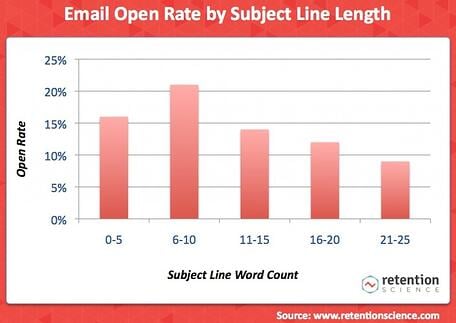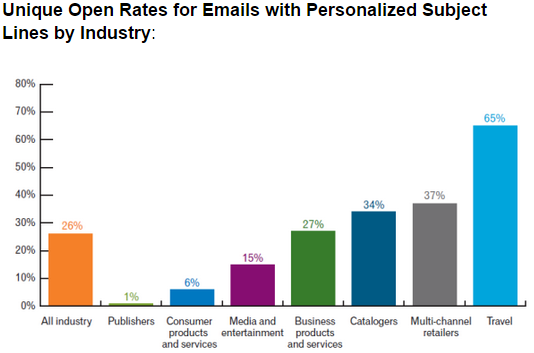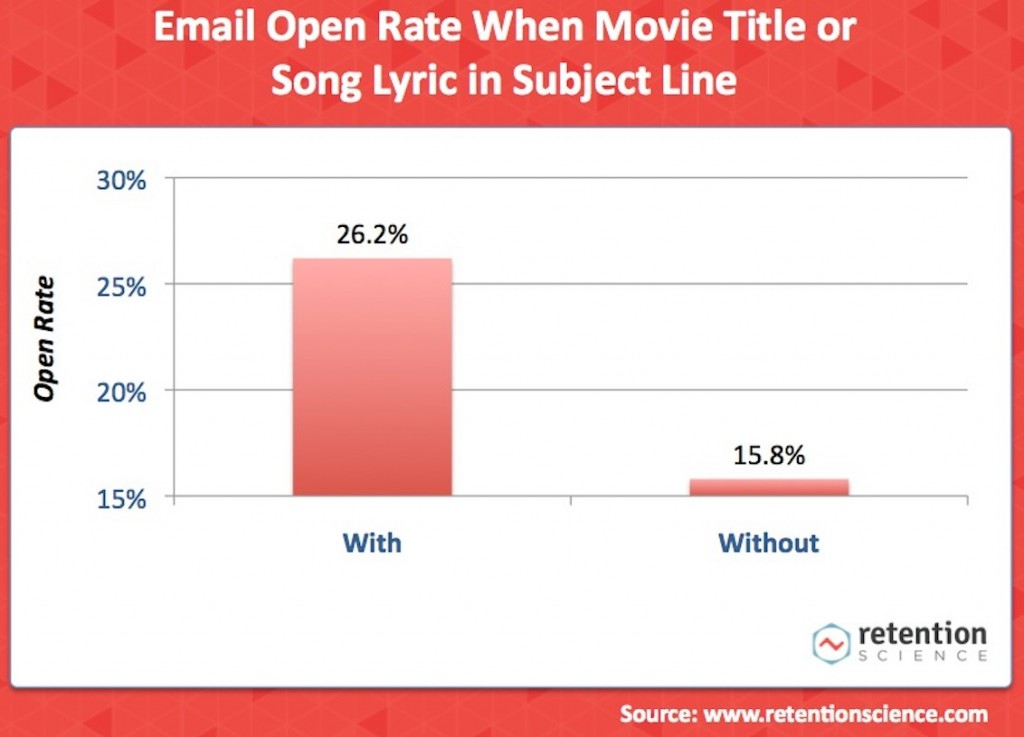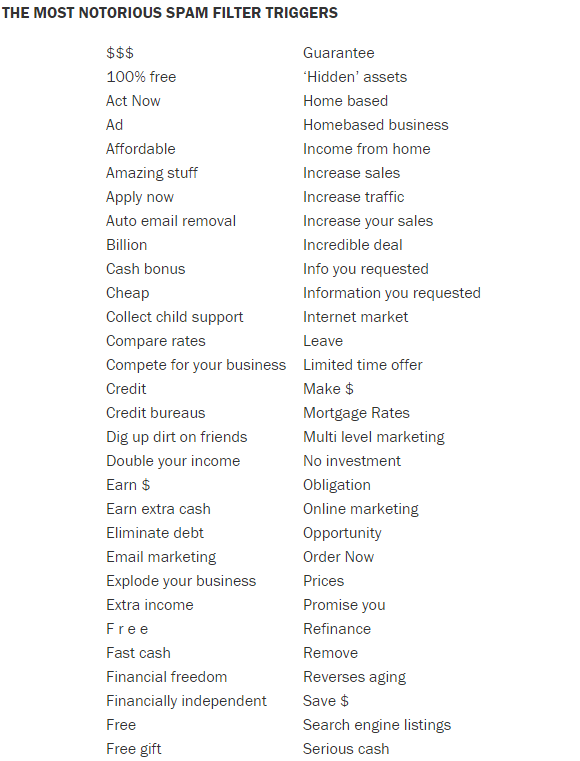Welcome to Tutorial Tuesday folks! Today we’ll be discussing the ‘fine art’ of email subject lines. Without any further ado, let’s take a quick trip down memory lane...
Remember those silly dandruff shampoo commercials from the 90’s? The ones that intoned we’d never get a second chance to make a first impression? Unlike many marketing aphorisms of the late 20th century, this statement still rings true. (Though the jury’s still out on whether the state of your scalp can ruin your chances of like, ever finding love or getting promoted or whatever.)
When it comes to sending emails, the subject line is your first impression. Don’t blow it.
There’s research and scientific data; then there’s opinion and personal experience. From my vantage point, both are equally valid. If you’re wondering what the singular most efficient and effective subject line is...well, it depends. Mostly, it depends of the intention of your email.
Are you sharing? Selling? Shilling? If you’re outreaching to a stranger in hopes of scoring a relevant resource listing or authorship placement on a blog roster, remember: this is one person speaking to directly to another person. Working in the digital realm, we often forget the human element.
Choosing your words wisely is absolutely essential...
Step One: What to Include in Your Subject Line
For such a seemingly small snippet, there are scores of studies examining open rates and click-thru traffic for subject lines. The words that perform best, the optimal length, exactly how personalized you should get, or whether or not to include a happy-face icon (spoiler: no).
The simplest of answers regarding what to include in the subject line? Not much. The facts are in: shorter is undoubtedly better.
A study by Retention Science showing open rate by word count.
A study by MailerMailer showing open rate by character count.
Do I actually count the characters in my subject lines? No, literally never, but brevity is obviously still key. Around 50% of emails (or 35%...or 65% -- depending on who you ask) are read on mobile devices. Keep small screens and short attention spans in mind.
-
Bad Example:
Subject: This one shampoo will probably change your life and get you more dates than you ever thought possible.
-
Good Example:
Subject: Nice hair, gorgeous.
A study proved the most successful subject line of President Obama’s email campaign was a succinct “Hey”. But that probably only works if you’re, y’know, the leader of the the free world.
When in doubt, go customized. Just make sure you know your audience.
An Experian personalization open rate study, via Marketing Land.
Must you spend an hour researching your contact’s childhood? Of course not. The balance is finding something that you personally relate to, without being disingenuous or preying on sentimentality.
-
Bad Example:
Subject: Guest post inquiry regarding head flakes.
-
Good Example:
Subject: Redheads DO have more fun.
See that lil’ 1% up there in the graph? Clearly, publishers from blogging platforms are bombarded with gibberish solicitation emails more often than the average webmaster. Genuine personalization is an absolute necessity.
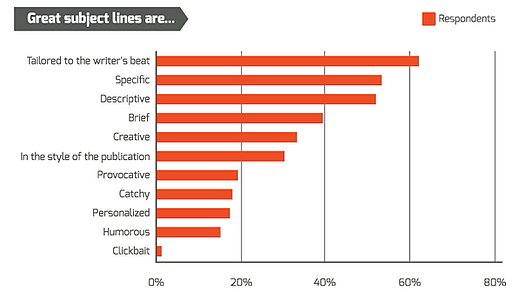 BuzzStream study on publisher-specific subject line preferences.
BuzzStream study on publisher-specific subject line preferences.
I guess ‘tailored’ is a hipper adjective than ‘personalized’? Either way, I think humor should be higher on the list. To be fair, it’s far better to not make a joke than to make a lame joke. But for the record, I love using terrible puns in my subject lines.
-
Bad Example:
Subject: Do you have a dandruff problem?
-
Good Example:
Subject: Whoa, what’s on your shoulder?
As far as personalization goes, tossing your contact’s name into the subject line is, quite literally, the least you can do. Including regional or other localized information is also said to boost open rates. (When applicable, of course.)
Creative reference subject line study by Retention Science.
Sincerely connecting shared interests is the brass ring. Movie references, music lyrics, literary quotes, sports team chants...whatever. If they’re into it and you’re into it? Use it.
-
Bad Example:
Subject: Dear Webmaster
-
Good Example:
Subject: Whip your hair... (Or a lyric from ‘Cut Your Hair’ if they’re more of a “Pavement type” than a “Willow Smith type”.)
What if you’ve actually been referred to this contact by another colleague, insider, or industry professional? Lead with that. Familiarity might breed contempt, but it’s also the best way to get your foot in the door when you know your foot belongs there.
Step Two: What to Avoid in Your Subject Line
First of all, an email is NOT an advertisement and the subject line is NOT a billboard. Second, there should be no “tricks” involved. You can’t pull the wool over someone’s eyes and expect it to work. Maybe they did open it...but then they got pissed, deleted it, and blacklisted you. Backfire!
Steer clear of any verbiage that sparks the inbox spam trigger.
A snippet from Mequoda’s list of spam-filter trigger words…
Promotional verbiage goes straight into the garbage can. Exclamation points are particularly unpopular. We do want to be sold things, we just don’t want to feel like we’re being sold things.
-
Bad Example:
Subject: 100% free trial of our amazing product!! Save MONEY!!!
-
Good Example:
Subject: Your hair deserves luxury, too.
This is not a text to your buddies. Use proper grammar and punctuation. Check your spelling. It’s unlikely that your outreach target or mailing list demographic is going to be app-happy high school sophomores, so make sure you look and sound like the professional that you are.
-
Bad Example:
Subject: OMG i h8 dandruff dont u
-
Good Example:
Subject: The science behind healthy hair...
Personal pet peeve territory: Why Do We Capitalize Every Word? A subject line isn’t a news headline or blog post title! The excessive capitalization is not conversational and looks entirely promotional. Whoever started this trend...is fired.
Step Three: A Few More Handy Tips and Tools
Being specific about the actual subject of your email is ideal, but how literal should it really be? For instance, an email from your favorite e-commerce site doesn’t say, “Just buy our shit.” (Though maybe it should...A/B testing, anyone?)
Nor should link building outreach simply state, “Link opportunity” or something similarly spammy and bland. What are you actually offering or trying to impart? Sometimes you want all the relevant information in the subject line; sometimes you just want people to be compelled to open the email.
I do know people who wholeheartedly swear by including kitten .gifs in their outreach or the ol’ fake-out reply (RE: This is actually the initial email) routine. I can’t actually recommend these.
Are your emails even being opened? Read? Are the links contained within the email being clicked on? Are you getting responses? How would you know? Luckily for us, there are tons of tools for these exact questions.
This tool for testing subject lines comes with rather thorough rating details:
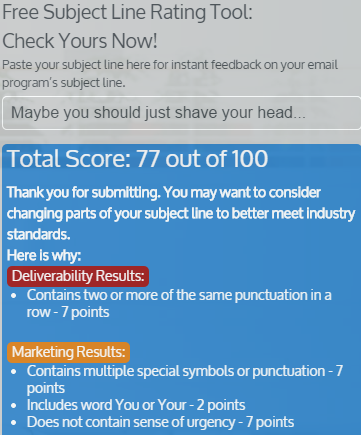 Minus seven points for an ellipsis?! I guess “Maybe you should shave your head…” is out, then.
Minus seven points for an ellipsis?! I guess “Maybe you should shave your head…” is out, then.
You can check to see if your email (including your subject line) passes the ‘spam test’ against a bazillion other examples. BuzzStream has a whole host of in-depth tools for seeing how your subject lines are performing and much more. RightInbox is an awesome Chrome extension worth trying, or Gmail offers extensions to track email metrics.
Conclusion: The Golden Rule
As far as I’m concerned, there is only one golden rule for determining the efficacy of your subject line: Would you open it?
I mean, would you really? You already know the answer to this. Do you sound automated? Unprofessional? Spammy? Overly promotional? Boring? What do you ignore when you have thirty new messages? What compels you to click? Go with your instincts.
You can also find over a hundred great examples in this post from Sleeknote.
That little sentence is your one shot at making an impression amidst the bevy of junk, scams, lackluster offerings and snooze-worthy correspondence that we all know as “Our Inbox”. Make sure you stick out, and for the right reasons.
Mail Chimp puts it so succinctly that I’ll quote them: “Don’t sell what’s inside. Tell what’s inside.”
Unless you’re making a really great pun, that is...
